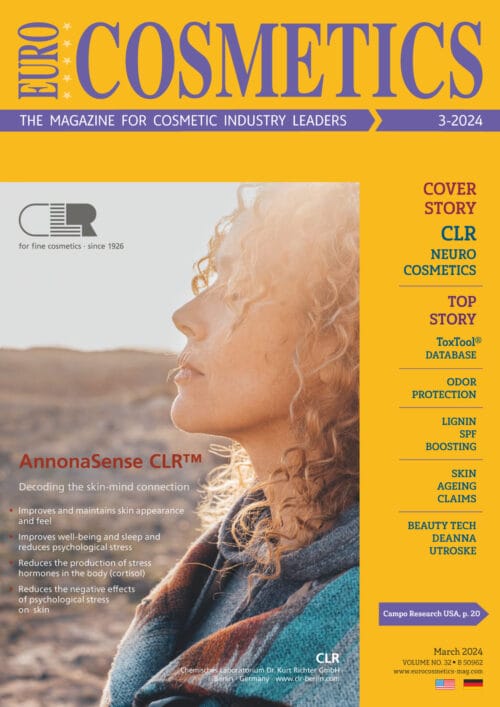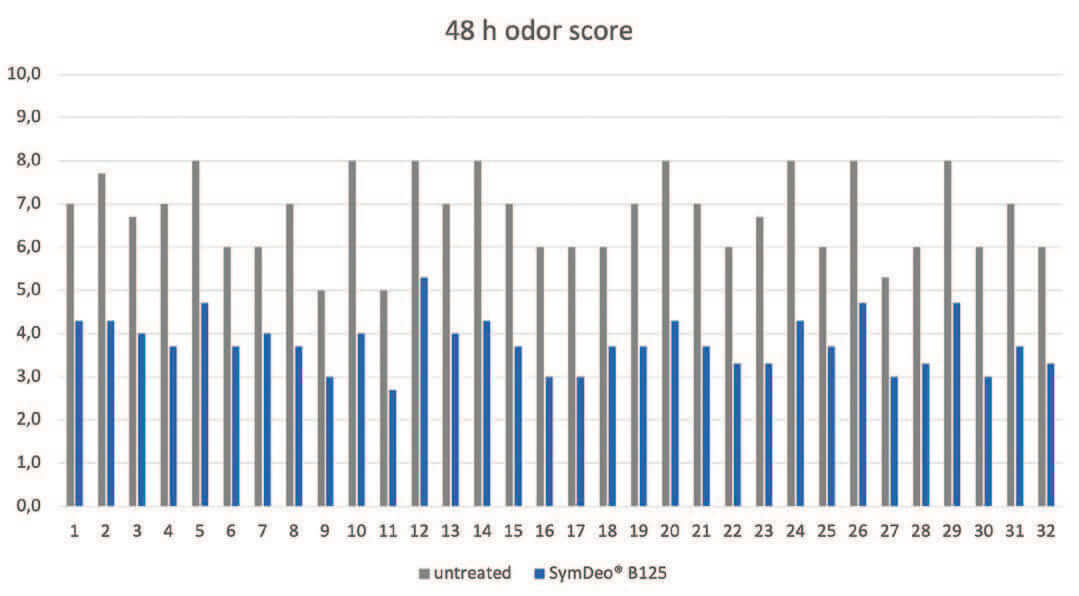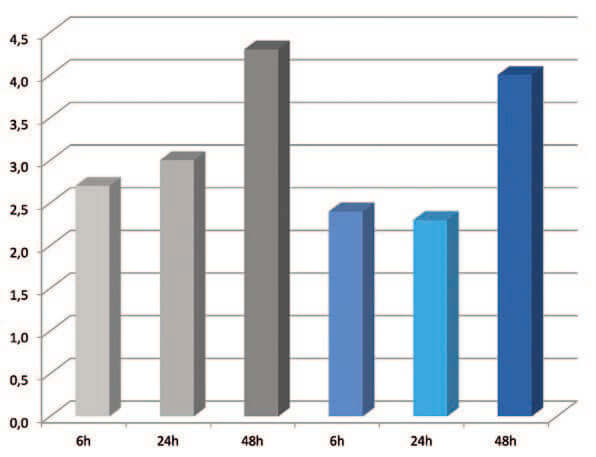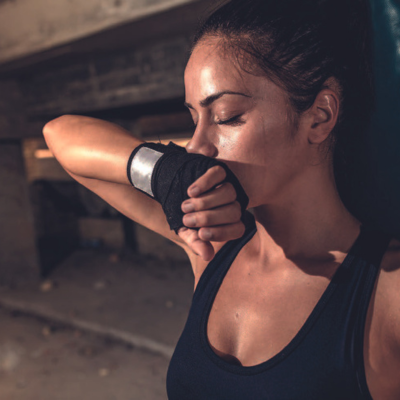
Human sweat, body odor formation, and prevention
Perspiration, also known as sweat, is the production of fluids secreted by sweat glands. In humans, two types of sweat glands can be found: eccrine glands and apocrine glands. Human perspiration has two essential functions: Eccrine sweat regulates our body temperature to remain around 37°C. Apocrine sweat, on the other hand, is the source of emotional sweating, serving as a medium for interpersonal communication.1
Regardless of its source: fresh sweat is odorless. Eccrine sweat does not contain any compounds that could cause body odor, as it is mainly composed of water, electrolytes, moisturizing factors, and free amino acids. Apocrine sweat, in contrast, contains complex
molecules like sebaceous or apocrine lipids, fatty acids, proteins, various glutamine- and cysteine conjugates, as well as pheromones.
Over time, the natural human skin microbiota degrades this nutrient-rich mixture, releasing smaller end products. These are typically small enough to be volatile and thus perceivable for
the surroundings, resulting in what is commonly called body odor.2
Customary strategies to manage human sweat odor can be categorized into three different technologies: Perspiration can be blocked locally by antiperspirants such as aluminum salts. The
reduction of moisture leads to reduced odor formation, due to pore clogging, absorption processes, and subsequent indirect limitation of bacterial metabolic activity. A second option is the direct inhibition of gram-positive bacteria, naturally resident on our skin. This can be achieved by utilizing deodorizing ingredients, that either reduce or inhibit microbial activity on the skin or limit their enzymatic activity. In contrast to antiperspirants, this approach does not influence the amount of perspiration. A third option is to reduce existing odor either by masking it with fragrance technologies or by neutralizing it with binding materials.

Deodorant and antiperspirant consumer market
Looking into the final cosmetic market, it is common practice to combine different technologies, mostly to satisfy the number one global consumer need from deodorants/antiperspirants: long-lasting protection against body odor with gentle and safe ingredients.
This becomes apparent when analyzing current products in the global deodorant and antiperspirant consumer market. 73% of the products launched in 2021 claimed long-lastingness, and the second most frequently used claim was alcohol-free with 33%.3
The use of deodorant actives supports cosmetic products in several ways to serve consumer needs flexibly. Primarily, they achieve effective odor protection from pure deodorant formulations without the use of aluminum. Odor protection even from low- or unfragranced products is feasible, and by combining the three technologies mentioned before, extra-long-lastingness concepts (i.e. 48 h, 72 h, 96 h claims) can be realized.
Alcohol-free deodorant performance
Serving the emerging alcohol-free trend we would like to report on two independent in-vivo studies containing our key deodorant ingredient SymDeo® B125 (2-methyl 5-cyclohexylpentanol)4. In these studies, we were able to demonstrate 48 h effectiveness
from two exemplary unfragranced non-AP spray and roll-on base formulations. We have already reported previously on the microbiome-friendly mode of action of SymDeo® B125 and its effectiveness at low concentrations.5, 6
Deodorant actives used in cosmetics often have a rather lipophilic nature. While this physicochemical property may be supportive for the ingredient’s activity and substantivity on skin it also means insolubility in water. This opens the question of which carrier to use in proof of principle in-vivo studies to demonstrate the ingredient’s own effect on the skin without being impacted by a complete formulation or fragrance. The carrier ideally needs to be odorless and volatile to only leave the active to unfold its activity on the skin (water and alcohol evaporate, the non-volatile active remains). For this reason, we have previously often relied on a simple hydroalcoholic solution of ethanol in water, ideally at a ratio of 40 to 60, meaning more water than alcohol, considering that alcohol only has an antimicrobial effect at higher concentrations,
i.e. >70%. Obviously, this is a question of solubility and in some cases, the alcohol concentration has to be chosen higher, depending on the active used. Thus, for an alcohol-free efficacy study, we chose a simple alternative volatile silicone carrier system instead of the hydroalcoholic solution, namely cyclohexasiloxane (D6) with the objective to assess the deodorant efficacy
of SymDeo® B125.
A double-blind sniffing test involving 3 trained assessors was carried out at an external institute. An odor scale from 0 (no odor) to 10 (extremely strong odor) was used in a left vs right armpit
study. The test product of 0.3% SymDeo® B125 in cyclohexasilox-ane (D6) was applied to 32 human subjects. Prior to the study, a 7-day conditioning period had to be completed. Subjects were only allowed to use a mild soap provided by the institute. To exclude the extremes, only the subjects with minor differences in the initial odor score comparing right vs left armpits of < 2 points were selected. The initial underarm odor had to be in the range between 3 to 7 points on the 0 –10 scale. Another prerequisite was a negative outcome of the control for residual aluminum in the armpits. On day 8 a single randomized application (left vs right underarm) of 0.3 g of the test product on one of the armpits was performed in the institute. Sniffing evaluation of both underarms (untreated and treated) before application and after 48 h was done and the results are displayed in figure 1. The study revealed a statistically significant (p<0.0001) odor reduction of 44% vs untreated for SymDeo® B125 applied at a concentration of 0.3%. An odor reduction was reported for all subjects. (Fig. 1) In a second external study, the deodorant efficacy of SymDeo® B125 was tested in a Spanish institute using an unfragranced rollon
deo formulation. A sniff test was run double blinded, involving 3 trained assessors. An odor scale from 0 (no odor) to 10 (very bad odor) was used in a left vs right armpit study. The tested
emulsion contained 0.3% SymDeo® B125 at a pH of 5.5 to 6. The study was conducted on a mixed panel with a total number of 30 male and female subjects in the age of 19 – 67. All participants were nonusers of aluminum antiperspirants and were double checked for residual aluminum in their armpits. Prior to the study, a 7-day conditioning period was completed. Subjects were only allowed to use a liquid neutral soap provided by the institute. The
probands chosen had only a minor difference in the initial odor score comparing right vs left armpits. On day 8 a single randomized application (left vs right underarm) of 1.3 –1.5 g of the
test product was applied by standardized application from a dispenser.
A sniffing evaluation of the underarms was conducted including initial odor before application and 6 h, 24 h & 48 h after application respectively. The results are illustrated in figure 2. The
study revealed a statistically significant (p<0.05) odor reduction of up to 24 h. Also, after 48 h an odor reduction vs untreated was notable. (Fig. 2)

a scale from 0 to 10 assessed by 3 experts in Spain by direct sniffing
of the armpits. Unfragranced Roll-on deo with 0.3% SymDeo® B125;
INCI: Aqua, Caprylic/Capric Triglyceride, Glyceryl Oleate Citrate, Glycerin,
2-Methyl 5-Cyclohexylpentanol, Hydroxyacetophenone, Tocopheryl
Acetate, 1,2-Hexanediol, Sodium Gluconate, Polyacrylate Crosspolymer
11.
Summary
The addition of deodorant actives to cosmetic formulations flexibly supports consumer confidence in several ways. Effective odor protection is possible also without the use of aluminum. By choosing the right deodorant ingredient an excellent performance also of low- or unfragranced formulations can be achieved. Combining different technologies facilitates the realization of extralong-lastingness concepts (i.e. 48 h, 72 h, 96 h claims).
The microbiome-friendly liquid ingredient SymDeo® B125 (2-methyl 5-cyclohexylpentanol) has shown to be an effective odor-prevention solution also for non-alcoholic or unfragranced
systems. SymDeo® B125 is a highly efficient deodorant active that is suitable for a wide range of alcohol-free deodorant formulations to ensure long-lasting odor protection.
Acknowledgments
This work was supported by the Symrise Cosmetic Ingredients Division’s regional application labs in Brazil and Spain.
References
- Symrise Cosmetic Ingredients; Body odor & Sweat glands: Multi sensorial sweating – sweat can be a result of temperature but also of emotions! www.symselect.com/multi_sensorial_sweating; last accessed Jan 2024.
- A. Natsch, CHIMIA (2015), 69, 414 – 420.
- Mintel’s Global New Products Database (GNPD), www.gnpd.com
- M. Pesaro, B. Diesing, G. Schmaus, R. Pillai; 2-Methyl 5-Cyclohexylpentanol: Development of a Novel Deodorant Agent; SOFW-Journal (Dec 2011), 137, 61– 68.
- F. Genrich, S. Nordzieke, C. Koch, G. Schmaus; Mind Your Microbes: Gentle Malodor Protection Supports the Axillary Microbiome; Cosmetics & Toiletries (Apr 2020) Vol 135; No. 4, 54 – 62.
- S. Nordzieke, F. Genrich, S. Behnke, C. Koch; Deodorising Ingredients with no microbiome impact; Personal Care Magazine global (Jan 2022) Vol 23; Issue 11, 44 – 46.



